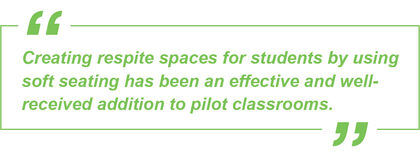Loading...

Patterns, Trends, and Observations - What Works (Part 2)
In my last post, I explored the design of pilot learning space programs. I’d now like to discuss the patterns, trends and outcomes that I have observed from implementing and evaluating a number of pilot programs. These results were obtained through survey work, direct observation of pilot classrooms, and teacher and student interviews from schools that were about to engage in significant spatial change.
What outcomes are apparent, consistent and interesting?
Teacher Expectations
In my initial survey work, I ask teachers how often they consider spaces as part of their instructional planning. The responses are always rarely to sometimes. I expect this - their spaces are not very good and that’s why I’m there. But when asked if new spaces would improve their teaching and student learning, they indicate that they would significantly improve or completely change the way in which they teach and the ways in which students learn. That’s always encouraging and even though their spaces might not be the best, teachers do recognize the potential impact of new spaces. It’s exciting to build upon that perspective.
Rethinking the Teacher Presence
The teacher desk in the front of the room is still a reality in most classrooms. During pilot work, I spend time helping schools rethink this. Removing the desk and other traditional elements of the front of the room can help teachers redefine the classroom space and how they engage the room and their students. This also frees up space (up to ⅓ to ½ of the classroom space in my experience) for new spatial designs that can employ unique furniture, such as the soft seating offered by Fōmcore.
Technology
If we remove the classroom desk, we can also remove the front of the room projector screen or interactive technology panel. Those elements define a “front of the room.” It has been my experience that a defined front of a classroom inhibits the emergence of new spatial designs by encouraging more traditional furniture arrangements. Adding a mobile technology display device that can be positioned anywhere in the space is an effective addition and supports creative space design. Ensuring that students can connect to this device with their technology tools to share their work adds another dimension to the classroom and how technology can support teaching and learning.
Classroom Zones
By reclaiming space in the classroom, we can add interesting spatial elements to the classroom. Creating conferencing and respite spaces for students by using soft seating has been an effective and well-received addition to pilot classrooms. Adding cafe standing height desking along the perimeter of the classroom activates this space and provides students with an option to engage in their classwork while standing up.
Spatial Diversity
I have found that creating new classroom zones and adding different furniture elements to improve the diversity of the classroom space is incredibly important. An increase in diversity provides options, which leads to student choice in how they use space, which in turn promotes ownership, which in my opinion, fosters the most effective type of student engagement.
David Jakes’ career as an educational designer has been influenced by the variety of roles and positions that he has held over 35 years. As a classroom science teacher, David developed a deep understanding of teaching and learning that has served as a foundation for his entire professional life....Read More